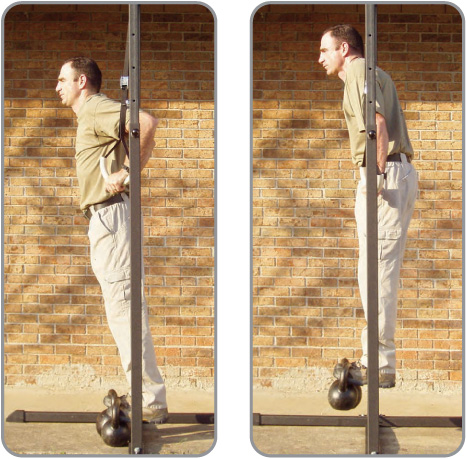
Question: What is the best way to make neck bridges harder?
For back bridges, old-timers held a weight on their chests, which is one option. Here is another that works even better. Lie on your back and get ready to bridge. Raise your arms overhead and hold on to a stationary object such as an upright of a power rack or a heavy kettlebell. Bend your elbows slightly and bring them closer together as if you are about to do a pullover. Pull your feet towards you and start back bridging, that is, push down with the back of your head until the top of your head rests on the mat.
Here is the wrinkle: as you are extending your neck, perform a low intensity isometric pullover. This is a self-resistance exercise; you can give your neck as much or as little resistance as you want which makes for a very thorough and safe workout.
For front bridges instead of using extra weight move your feet further back and rest your weight on your forehead rather than the top of your head. Spot yourself with your hands. To get a stronger contraction ‘flare’ your neck.
Question: I’ve been told that exercises on the rings are largely responsible for gymnasts’ awesome strength and built. I’m way too heavy for iron crosses and such; could I still benefit from ring training?
You bet. The first exercise that comes to mind is the pushup, your feet up on a bench and the rings set up a few inches off the ground. Strength coach extraordinaire Ethan Reeve has his athletes at Wake Forest University in North Carolina combine these with Power Breathing for a greater contraction. Mr. Olympia Larry Scott (LarryScott.com) used to do flies on the same type of rig – an unbelievably powerful and challenging pecs exercise!
Rings are great for pullups and chinups and they are a lot kinder to the elbows than the straight bar. All of the ring drills have a fun, athletic feel to them and are brutal on the prime mover and stabilizer muscles alike. The great variety of ring exercises is limited only by your imagination.
There are many ways to customize the difficulty of ring exercises to any level. You could incline or decline your body. You could extend or flex your arms. You could hang one ring higher than the other. And these are just a handful of many possibilities.
Competition gymnastic rings are pricey and you don’t need them anyway. I like the rings made by RingTraining.com. They are light enough to throw into your gym bag and you can hook them up to a power rack or basement rafters and take them down in seconds. The above website also offers plenty of free ring training advice for athletes who are not gymnasts.
Question: What is a good exercise to build strength for handstand pushups? I wouldn’t mind building my delts at the same time.
The following unique incline pushup from the gymnasts’ arsenal has been practiced by great Jack La Lanne. Put your feet up on a chair, but instead of keeping your body in a straight line jackknife it at the hips so your hips are way up in the air. La Lanne instructs to keep your legs rigid and to place your hands as close to the chair as possible. In other words, as close as your strength allows. The nearer your hands are to your feet, the more jackknifed is your body. The pec involvement decreases and your delts have to work extra hard, almost as if you are doing a handstand pushup.
You can also vary the difficulty of the drill by redistributing the weight between your feet and hands. Once you get pretty good, shift weight so much on to your hands that you come close to overbalancing and making a forward tumble. Be careful.
In order to work your delts hard do not look at the floor but rather touch it with the crown of your head. It is a very important fine point!
If you manage the basic incline jackknife pushup with ease, try putting your feet up on a Swiss ball or an office chair on wheels for extra excitement. You can also increase the range of motion by elevating your hands on stools. Put up your feet even higher than before, if you go this route.
The La Lanne pushup is guaranteed to fill out your shoulders and build your overhead pressing strength – fast.
Question: I am trying to ace the USMC pullup test with 20 but I am stuck at 17. My grip gives out first; how should I train?
Rock climbers know that once your forearms get pumped, you are toast. Incidentally, the jarhead who holds the USMC pullup record is a climber. During his record attempt he would periodically hang on one arm while shaking out and resting the other. Following is a technique we used in the Russian military to build our pullup specific grip strength.
The technique is a variation of the rest-pause, although the ‘no rest pause’ would be a more appropriate name. Do a pullup, then hang for a specified period of time, usually five to ten seconds, and do another rep. Hang some more, do a pullup, etc. Incredibly simple and highly effective.
The Russian rest pause works with most high rep exercises. Kettlebell lifting competitors sometimes purposefully slow down their jerk tempo to five reps a minute in training. Even if the grip is not an issue, a special type of isometric fatigue builds up in extended sets. Improving your specific endurance in holding, say, the pushup lockout will improve your pushup numbers. Do five or ten pushups and pause in the top position without sagging for fifteen seconds, then do another ten, and keep on going.
Add a day of Russian rest pause training to your regular pullup week and you will score 100% on that PFT test. Or else.
Question: I heard that you teach a special kind of parallel bar dip to S.W.A.T. teams. I am curious, what is different about it and is there any reason for a bodybuilder to do it?
As demonstrated in my Rapid Response video set, the S.W.A.T. dip to the regular dip is what the bench press from the power rack pins set at the chest level is to the regular bench. Safer and harder.
Without any extra weight, slowly lower yourself as deep as your shoulders find comfortable. Straighten out your legs and note how close your feet are to the ground. Get out and rig up a box or some other sturdy object to support you exactly at that level.
Jeff Martone, RKC Sr. does the advanced S.W.A.T. dip on the rings.
Photos courtesy TacticalAthlete.com
Climb on the box, place your hands on the bars. Inhale and tighten up your body. Squeeze the bars and straighten out your arms. Make sure not to cheat by jumping; keep your knees locked and your feet flat.
Lock out and move up as high as possible by pressing your shoulders away from your ears by tensing your lats and pecs. Lower yourself under control, keeping your legs straight and your feet parallel to the deck. Touch down lightly and relax completely before the next rep. You will quickly realize that overcoming a dead weight without a pre-stretch and a bounce is a real bear. Like a squat from the low pins.
Once you get the groove down pile on weight. No more sore shoulders and stretch marks. Hello, powerful and healthy shoulder girdle!
Question: Should I work my neck directly?
If you want to build a neck so muscular that you have to turn your whole torso as a gun turret to face someone go get yourself a neck harness and go nuts on heavy shrugs. If the prospect of ordering custom made dress shirts does not excite you and you are satisfied with the size you are getting from your regular routine, you should still include the following exercise into your regimen.
The rolling neck bridge will strengthen your neck from every direction and make you a lot more injury proof. Besides, it feels awesome when your traps are fried from heavy deads and shrugs. Really gets those kinks out.
Start with an easier version of the drill. Stand a couple of feet away from the wall and lean against it with your forehead while keeping your body rigid. You may wear a hat if the wall is too rough or you have a thing against greasy spots on your wallpaper.
Move your feet in place and slowly rotate, so first the side of your head presses against the wall, then the back, etc. until you make a full circle. Spot your self with your hands.
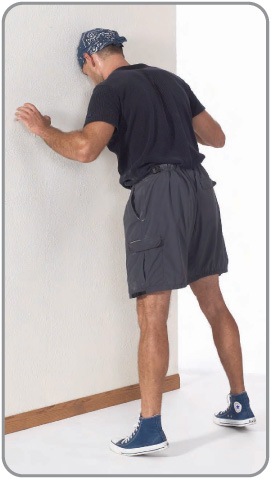
The rolling neck bridge (standing).
Make a very smooth transition of the load from muscle to muscle as you are spinning. It is not as easy as it sounds. What will help is tightening other muscles on the side of your body that faces the wall. The key word here is ‘linkage’! When you face forward, flex your abs and thighs. When you face away, tense your back, glutes, and hams. Tighten your obliques, etc. when you are sideways. Keep your head fairly neutral throughout.
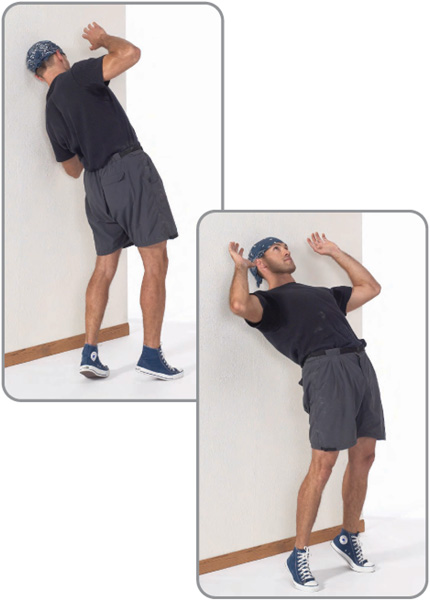
When you feel ready, try the same on the floor. You will have to keep your body semi-bridged unless your neck strength is truly freaky. Do not confuse this drill with the true wrestler’s bridge that hyperextends and hyperflexes the neck; keep your head almost in line with your body! Do not think this will make the exercise easier; just the other way around!
One more time: keep your body tensed and semi-bridged!
Carefully spot yourself with your hands at all times; breaking your neck is not on the agenda. You will find that your shoulders are also helping by unloading your neck as they roll on the ground. That is fine, at least until wrestlers start asking you what have you been doing for your neck.
The rolling neck bridge.
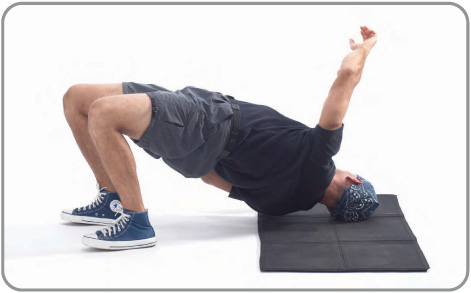
Carefully spot yourself with your hands at all times; breaking your neck is not on the agenda.
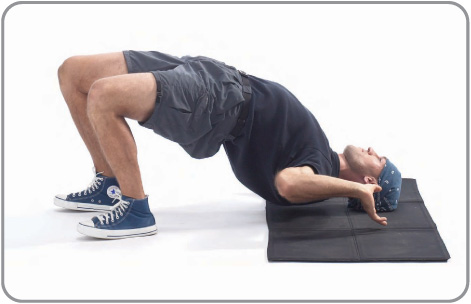
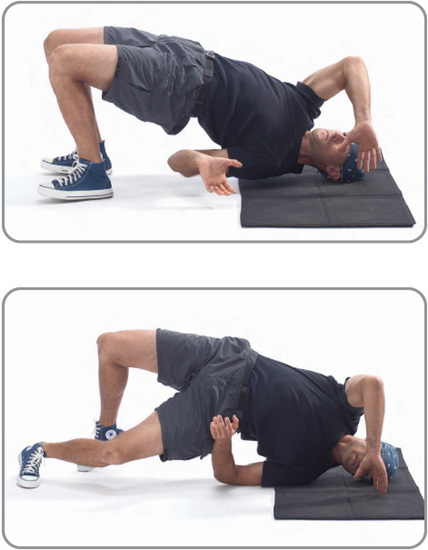
The rolling neck bridge will strengthen your neck from every direction and make you a lot more injury proof.
Question: You mentioned that in Russia a bodybuilder is considered a raw beginner until he can do twenty pullups. I have decided to achieve the 20 mark, hell or high water. Should I add weight to my pullups to get there faster?
Yes, if you already can do at least ten pullups and the extra weight is light. ‘Light’ is the secret. While hanging a heavy kettlebell on your waist will build absolute strength, it might not make an impression on your high rep efforts. Yes, you will fly through your first few reps once you take off the weight belt but you will wilt shortly afterwards. Specificity, comrades. Ten to twenty-five pounds of extra poundage is about right. If, for instance, you can do fifteen unweighted pullups, a quarter will bring you down to below ten but not as low as five. Alternating pullup workouts with and without extra weight will bring about the greatest gains.
Q: You have convinced my training partner and myself to do pullups from a dead hang. It works, my armpits are finally chafing! Is there a way to make the exercise even stricter and more brutal?
For a Tactical Strength Challenge competition hosted by Maxercise gym in Philadelphia, evil genius Steve Maxwell, RKC Sr., MS rigged up a pullup bar suspended on chains. The chains enforced ultra strict performance; any attempt to jerk or cheat made the competitor swing, get out of the groove, and sometimes slam into the wall! To give you an idea of the increased difficulty, Level 2 runner-up John Allstadt can crank out 14 dead hang, neck to the bar pullups with a 70-pound kettlebell on a stationary bar. The Maxercise bar stopped him at 8! Definitely consider this type of rig for your home gym; a plumbing pipe, a couple of chains, and the fittings to hold it all together and attached to the rafters is all you need. At the club you can suspend a barbell from chains hooked to the top of the power rack with carabiners. Or you could buy the Dual Suspension System from MilitaryFitness.org. Enjoy the pain!